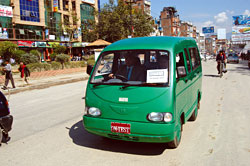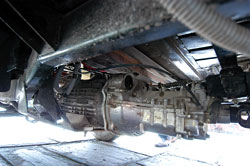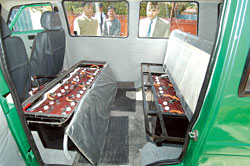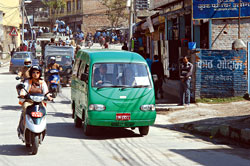 GREEN WITH ENVY: The MiniEv as it cruises down Baneswor on Thursday with hardly a sound. The motor under the car is a neat little thing (below,left to right) the 14 six-volt batteries are under the seat covers and the inverter and charger fit inside the driver's seat.
GREEN WITH ENVY: The MiniEv as it cruises down Baneswor on Thursday with hardly a sound. The motor under the car is a neat little thing (below,left to right) the 14 six-volt batteries are under the seat covers and the inverter and charger fit inside the driver's seat.
The new Hulas MiniEV is a traffic hazard because it is so quiet you can't hear it coming. Driving the electric van it is mandatory to honk so other road users know you are there.
On a test drive this week, the only time the van emitted a half-purr half-whine was when it was doing the 15 percent incline up Swayambhu with three passengers and driver. At a traffic light, the driver gets the feeling the engine has cut out and the fingers reflexively go to the ignition switch. With only a small rattle coming from the rear of the fiberglass chassis this is a ride smoother and quieter than on a SUV.  The Italian-made 8 kilowatt Zapi motor is a dream, and kicks in powerfully when you step on the gas, oops sorry, pedal.
The Italian-made 8 kilowatt Zapi motor is a dream, and kicks in powerfully when you step on the gas, oops sorry, pedal.
You don't need to hit the brakes because taking the foot off the accelerator automatically puts the motor on regenerative braking which means it goes into recharging mode to convert kinetic energy that would otherwise be wasted.
So we get to the parking lot. And the hand once more instinctively goes to the gear knob to put the car on reverse. Wrong again. You put the car on reverse by turning a switch on the dash board and pressing the accelerator. Careful, though, the motor on reverse packs quite a torque so you feel the van lurch backwards.  On the downhill, the van coasts without brakes and the Zapi is busy putting the energy to good use by recharging the 14 six-volt batteries under the seatcover. Honk to alert the kids trying to cross the road, honk again to overtake the motorcycle, honk out of sheer delight.
On the downhill, the van coasts without brakes and the Zapi is busy putting the energy to good use by recharging the 14 six-volt batteries under the seatcover. Honk to alert the kids trying to cross the road, honk again to overtake the motorcycle, honk out of sheer delight.
The Mini-V doesn't turn heads because with its green enamel skin it looks just slightly bigger than a Maruti Omni. Hulas Motors of Biratnagar has used its Mini platform for electric conversion with the help of the Kathmandu Electric Vehicles Alliance (KEVA) . The alliance has worked to popularise Safa Tempos in Kathmandu and recently partnered with Bank of Kathmandu to help 20 women get owner-driven Safas. It wants to use this experience now to promote electric four wheelers.
"Because of the success of Safa Tempos, Nepalis have always thought electric cars are only three wheelers, that is why we want to bring in four-wheelers for personal and business use," says KEVA's Bibek Chapagain. KEVA is working with Surendra Golchha at Hulas with support from SDC and USAID to promote the MiniEV as an economically and ecologically attractive vehicle for Nepal.  Indeed, the MiniEV compares favourably with the Rs 900,000 cost price of the Maruti Omni and is half as cheap to run as the Rs 7 per km that it costs to operate the Omni at present electricity and gas prices. (See box) Aside from the economic factors, owners of MiniVs can also sleep more soundly at night knowing they haven't pumped more carbon dioxide into the atmosphere. Just to compare, the 600 electric Tempos in Kathmandu prevent more than 8 tons of carbon from being emitted every year. Imagine how much more we could do if electric cars were more popular.
Indeed, the MiniEV compares favourably with the Rs 900,000 cost price of the Maruti Omni and is half as cheap to run as the Rs 7 per km that it costs to operate the Omni at present electricity and gas prices. (See box) Aside from the economic factors, owners of MiniVs can also sleep more soundly at night knowing they haven't pumped more carbon dioxide into the atmosphere. Just to compare, the 600 electric Tempos in Kathmandu prevent more than 8 tons of carbon from being emitted every year. Imagine how much more we could do if electric cars were more popular.
KEVA's Megesh Tiwari works on managing the program and says: "While the rest of the world is into energy independence we in Nepal have a solution staring at us right in the face. It is the electric vehicle that you can charge at night during off-peak periods."  Both KEVA and Hulas are realistic enough to know that the MiniEV will not catch on immediately with cautious car buyers. That is why they are first targeting 'green consumers' and hope that the economic argument will steadily win over the others.
Both KEVA and Hulas are realistic enough to know that the MiniEV will not catch on immediately with cautious car buyers. That is why they are first targeting 'green consumers' and hope that the economic argument will steadily win over the others.
The MiniV isn't a Toyota Prius: it doesn't have the looks, the range, or the power. But unlike the hybrid Prius it is fully-electric and perfectly suited for Kathmandu's distances. And it makes even more sense during blockades or when the gas prices go up again as they surely will.
Markus Eisenring, the Swiss engineer who helped design the electric drive in the MiniEV and Anil Bajracharya say it is a very sturdy system and they wouldn't mind owning one of the cars themselves.  It takes only three hours to ensure near-full charge of the battery pack which will run for up to 70 km. Considering most all-day driving in Kathmandu Valley for delivery vans and commuters rarely exceeds 40 km, this is quite manageable.
It takes only three hours to ensure near-full charge of the battery pack which will run for up to 70 km. Considering most all-day driving in Kathmandu Valley for delivery vans and commuters rarely exceeds 40 km, this is quite manageable.
With proper use, the batteries can last up to three years and will cost Rs 80,000 for replacement. Unlike the Safa, the MiniEV comes with an inbuilt charger, and you can just plug it into a 15 Amp wall socket.
So, what are you waiting for? Call KEVA and book you MiniEV now before people wise up and there is a long waiting list.
01-4467087
www.keva.org.np
 Maruti Omni |  Hulas MiniV | |
| Cost | Rs 890,000 | Rs 900,000 (estimate) |
| Mileage | Rs 6.7/km | Rs 1.8/km (plus battery depreciation) |
| Range | 300 km on full tank | 70 km on full chargex |
| Made in | India | Nepal |
| Exhaust | Carbon dioxide, carbon Zero Emission monoxide, nitrous oxide, sulfur dioxide, benzine, soot particles. | Zero Emission |


